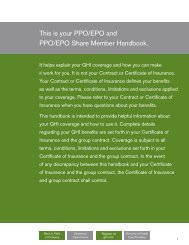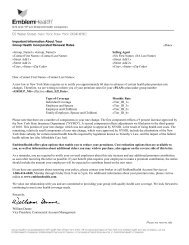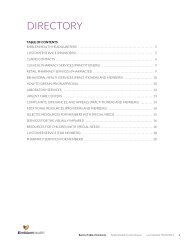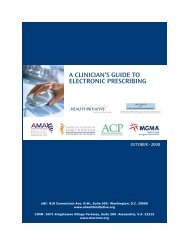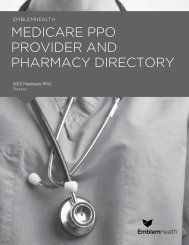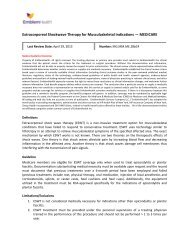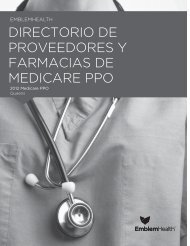PPO II - EmblemHealth
PPO II - EmblemHealth
PPO II - EmblemHealth
You also want an ePaper? Increase the reach of your titles
YUMPU automatically turns print PDFs into web optimized ePapers that Google loves.
162 2013 Evidence of Coverage for <strong>PPO</strong> <strong>II</strong><br />
Chapter 9: What to do if you have a problem or complaint<br />
(coverage decisions, appeals, complaints)<br />
When you ask for an exception, your doctor or other prescriber will need to explain the medical reasons<br />
why you need the exception approved. We will then consider your request. Here are three examples of<br />
exceptions that you or your doctor or other prescriber can ask us to make:<br />
1. Covering a Part D drug for you that is not on our List of Covered Drugs (Formulary). (We call it<br />
the “Drug List” for short.)<br />
Legal<br />
Terms<br />
Asking for coverage of a drug that is not on the Drug List is sometimes called asking for a<br />
“formulary exception.”<br />
• If we agree to make an exception and cover a drug that is not on the Drug List, you will need to<br />
pay the cost-sharing amount that applies to drugs in Tier 3. You cannot ask for an exception to<br />
the copayment or coinsurance amount we require you to pay for the drug.<br />
2. Removing a restriction on our coverage for a covered drug. Th ere are extra rules or restrictions that<br />
apply to certain drugs on our List of Covered Drugs (Formulary) (for more information, go to Chapter<br />
5 and look for Section 5).<br />
Legal<br />
Terms<br />
Asking for removal of a restriction on coverage for a drug is sometimes called asking for a<br />
“formulary exception.”<br />
• Th e extra rules and restrictions on coverage for certain drugs include:<br />
� Being required to use the generic version of a drug instead of the brand name drug.<br />
� Getting plan approval in advance before we will agree to cover the drug for you. (Th is is<br />
sometimes called “prior authorization.”)<br />
� Being required to try a diff erent drug fi rst before we will agree to cover the drug you are<br />
asking for. (Th is is sometimes called “step therapy.”)<br />
� Quantity limits. For some drugs, there are restrictions on the amount of the drug you can<br />
have.<br />
• If we agree to make an exception and waive a restriction for you, you can ask for an exception to<br />
the copayment or coinsurance amount we require you to pay for the drug.<br />
3. Changing coverage of a drug to a lower cost-sharing tier. Every drug on our Drug List is in one of<br />
four cost-sharing tiers. In general, the lower the cost-sharing tier number, the less you will pay as your<br />
share of the cost of the drug.<br />
Legal<br />
Terms<br />
Asking to pay a lower preferred price for a covered non-preferred drug is sometimes called<br />
asking for a “tiering exception.”<br />
• If your drug is in Tier 3 you can ask us to cover it at the cost-sharing amount that applies to<br />
drugs in Tier 2. Th is would lower your share of the cost for the drug.<br />
• You cannot ask us to change the cost-sharing tier for any drug in Tier 4 – Specialty Drugs.





